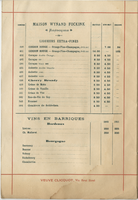Search the Special Collections and Archives Portal
Search Results
Jay Sarno Photograph Collection
Identifier
Abstract
The Jay Sarno Photograph Collection (1947-1983) contains photographs from hotel and casino developer Jay Sarno. The photographs primarily depict Sarno and his family. The photographs also depict some of Sarno's development projects, including Circus Circus, Caesars Palace, and the Grandissimo. The photographs depict construction of the hotels, events, and famous figures.
Archival Collection
William Flangas Scrapbooks
Identifier
Abstract
The William Flangas Srapbooks document his anti-smoking efforts in Nevada from 1974 to 2014. These materials include correspondence, articles, copies of assembly bills, newsletters related to smoking and health, and newsletters related to non-smokers.
Archival Collection
Archie and Zora Grant Papers
Identifier
Abstract
The Archie and Zora Grant Papers document the lives of Archie and Zora Grant from 1918 to 1973. Materials include scrapbooks, clippings, correspondence, records, certificates, and awards pertaining to Archie’s career in the Nevada Legislature, the State Board of Education, Las Vegas Housing Authority, and Las Vegas Chamber of Commerce.
Archival Collection
Eileen Brookman Papers
Identifier
Abstract
The Eileen Brookman Papers date from 1934 to 2002 and document Brookman's personal life and political career. Brookman was active in the Las Vegas Jewish community. Personal papers include programs from B'nai B'rith, scrapbook materials, correspondence, and photographs. The collection includes documentation from the White House Conference on Aging. She served several terms in the Nevada State Assembly from 1967 to 1977 and again from 1987 to 1989. Political materials include legislative information, bumper stickers, election returns, and newspaper clippings.
Archival Collection
Lake-Eglington Family Photograph Collection
Identifier
Abstract
The Lake-Eglington Family Photograph Collection contains photographs of the Lake-Eglington Family in and around Las Vegas, Nevada from 1900 to 1976. The materials include photographs of early Las Vegas resident Olive Lake-Eglington and her family shortly after they moved to Las Vegas in 1904, as well as her eventual husband Earle Eglington after he moved to Las Vegas in 1911. The materials also include photographs of Native American artifacts, schools in Clark County, Nevada, artesian wells, the Hoover (Boulder) Dam, the Colorado River, Mt. Charleston, the Mormon Fort, the Stewart (Kiel) Ranch, the Las Vegas Ranch, and many early residents of Las Vegas.
Archival Collection
Archie C. Grant Photograph Collection
Identifier
Abstract
The Archie C. Grant Photograph Collection (1914-1968) contains black-and-white photographs of Nevada politician Archie C. Grant. The materials include photographs of Grant with the Las Vegas Housing Authority at groundbreaking ceremonies, the University of Nevada Board of Regents, and with other Nevada politicians. Materials also contain early photographs of the University of Nevada, Las Vegas campus, including the dedication of Maude Frazier Hall.
Archival Collection
Scott Henry Photographs of the Las Vegas, Nevada Latinx Community
Identifier
Abstract
The Scott Henry Photographs of the Las Vegas, Latinx Community (approximately 1983-2000) consist of 42 photographic prints depicting members of the Latinx community in Las Vegas, Nevada. Thirty-eight of the prints were used as part of a collaborative project between Scott Henry, photographer and editor for the Las Vegas Review-Journal, and Thomas Rodriguez, a prominent member of the Latinx community in Las Vegas, for an exhibit of the Las Vegas Latinx community. Henry and Rodriguez together planned who to photograph for the exhibit. The photographs demonstrate the impact that the Latinx community has on the region's political, economic, and social growth and development. A number of the photographs show early members of the League of United Latin American Citizens (LULAC), including John Mendoza, Delia Martinez, Tom Rodriguez, Bob Agonia, Corrine Gutierrez, Nick Flores, Grace Salazar, and Gus Ramos.
Archival Collection
Marjorie Barrick Museum of Natural History Records
Identifier
Abstract
The Marjorie Barrick Museum of Natural History Records (1939-2003) detail the creation of the Marjorie Barrick Museum of Natural History in Las Vegas, Nevada founded by Richard H. Brooks, a professor of anthropology at the University of Nevada, Las Vegas. The records are comprised primarily of correspondence between Brooks and members of the Southwestern Anthropological Association (SWAA), the Society for California Archaeology (SCA), and the meetings and exhibitions of the Nevada State Museum. The collection also contains financial statements that describe expenses for supplies, research, and excursions. Also included are anthropological, archaeological, and historical publications, as well as administrative files and Richard Brooks' correspondence with the Nevada Archaeological Survey (NAS). The collection also includes architectural floor plans for the Classroom and Physical Education, the original space that was converted into the museum in 1980, and plans for the redesign of the Barrick Museum and the Harry Reid Environmental Research Center addition.
Archival Collection
Charley Henchis Papers
Identifier
Abstract
The Charley Henchis Papers (approximately 1945-1987) document the career of international cabaret show producer Charley Henchis and the shows he produced in Las Vegas, Nevada and Beirut, Lebanon. Materials include Henchis' business files which includes correspondence, files on specialty acts, photographs, and press about Henchis. Shows represented in this collection includes
Archival Collection

